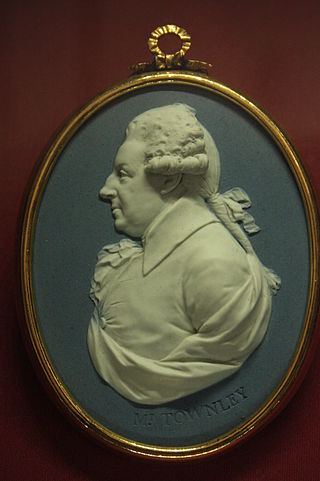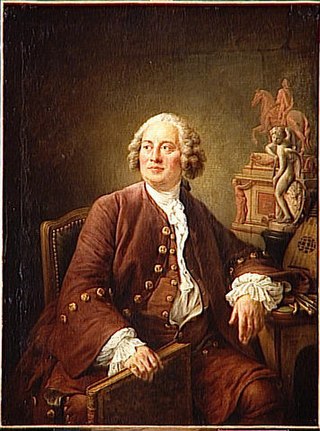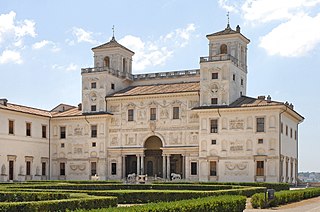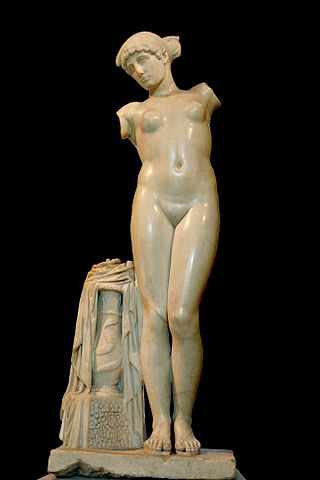
Charles Townley FRS was a wealthy English country gentleman, antiquary and collector, a member of the Towneley family. He travelled on three Grand Tours to Italy, buying antique sculpture, vases, coins, manuscripts and Old Master drawings and paintings. Many of the most important pieces from his collection, especially the Townley Marbles are now in the British Museum's Department of Greek and Roman Antiquities. The marbles were overshadowed at the time, and still today, by the Elgin Marbles.

Giambologna, also known as Jean de Boulogne (French), Jehan Boulongne (Flemish) and Giovanni da Bologna (Italian), was the last significant Italian Renaissance sculptor, with a large workshop producing large and small works in bronze and marble in a late Mannerist style.

Edmé Bouchardon was a French sculptor best known for his neoclassical statues in the gardens of the Palace of Versailles, his medals, his equestrian statue of Louis XV of France for the Place de la Concorde ; and for the Fountain of Four Seasons in Paris. He was also a draftsman and painter, and made celebrated series of engravings of working-class Parisians.

The life-size ancient but much restored marble statue known as the Barberini Faun, Fauno Barberini or Drunken Satyr is now in the Glyptothek in Munich, Germany. A faun is the Roman equivalent of a Greek satyr. In Greek mythology, satyrs were human-like male woodland spirits with several animal features, often a goat-like tail, hooves, ears, or horns. Satyrs attended Dionysus.

Gavin Hamilton was a Scottish neoclassical history painter, who is more widely remembered for his searches for antiquities in the neighbourhood of Rome. These roles in combination made him an arbiter of neoclassical taste.

The Villa Medici is a Mannerist villa and an architectural complex with a garden contiguous with the larger Borghese gardens, on the Pincian Hill next to Trinità dei Monti in Rome, Italy. The Villa Medici, founded by Ferdinando I de' Medici, Grand Duke of Tuscany and now property of the French State, has housed the French Academy in Rome since 1803. A musical evocation of its garden fountains features in Ottorino Respighi's Fountains of Rome.

The Venus de' Medici or Medici Venus is a 1.53 m tall Hellenistic marble sculpture depicting the Greek goddess of love Aphrodite. It is a 1st-century BC marble copy, perhaps made in Athens, of a bronze original Greek sculpture, following the type of the Aphrodite of Knidos, which would have been made by a sculptor in the immediate Praxitelean tradition, perhaps at the end of the century. It has become one of the navigation points by which the progress of the Western classical tradition is traced, the references to it outline the changes of taste and the process of classical scholarship. It is housed in the Uffizi Gallery, Florence, Italy.

The Capitoline Venus is a type of statue of Venus, specifically one of several Venus Pudica types, of which several examples exist. The type ultimately derives from the Aphrodite of Cnidus. The Capitoline Venus and her variants are recognisable from the position of the arms—standing after a bath, Venus begins to cover her breasts with her right hand, and her groin with her left hand.

The Esquiline Venus, depicting the goddess Venus, is a smaller-than-life-size Roman nude marble sculpture of a female in sandals and a diadem headdress. It is widely viewed as a 1st-century AD Roman copy of a Greek original from the 1st century BC. It is also a possible depiction of the Ptolemaic ruler Cleopatra VII.

The Crouching Venus is a Hellenistic model of Venus surprised at her bath. Venus crouches with her right knee close to the ground, turns her head to the right and, in most versions, reaches her right arm over to her left shoulder to cover her breasts. To judge by the number of copies that have been excavated on Roman sites in Italy and France, this variant on Venus seems to have been popular.

The Arrotino, or formerly the Scythian, thought to be a figure from a group representing the Flaying of Marsyas is a Hellenistic-Roman sculpture of a man crouching to sharpen a knife on a whetstone.

Bartolomeo Cavaceppi was an Italian sculptor who worked in Rome, where he trained in the studio of the acclimatized Frenchman, Pierre-Étienne Monnot, and then in the workshop of Carlo Antonio Napolioni, a restorer of sculptures for Cardinal Alessandro Albani, who was to become a major patron of Cavaceppi, and a purveyer of antiquities and copies on his own account. The two sculptors shared a studio. Much of his work was in restoring antique Roman sculptures, making casts, copies, and fakes of antiques, fields in which he was pre-eminent and which brought him into contact with all the virtuosi: he was a close friend of and informant for Johann Joachim Winckelmann. Winckelmann's influence and Cardinal Albani's own evolving taste may have contributed to Cavaceppi's increased self-consciousness of the appropriateness of restorations — a field in which earlier sculptors had improvised broadly — evinced in his introductory essay to his Raccolta d'antiche statue, busti, teste cognite ed altre sculture antiche restaurate da Cav. Bartolomeo Cavaceppi scultore romano. The baroque taste in ornate restorations of antiquities had favoured finely pumiced polished surfaces, coloured marbles and mixed media, and highly speculative restorations of sometimes incongruous fragments. Only in the nineteenth century, would collectors begin for the first time to appreciate fragments of sculpture: a headless torso was not easily sold in eighteenth-century Rome.

Thomas Jenkins was a British artist who went to Rome accompanying the British landscape-painter Richard Wilson about 1750 and remained behind, establishing himself in the city by serving as cicerone and sometimes banker to the visiting British, becoming a dealer in Roman sculpture and antiquities to a largely British clientele and an agent for gentlemen who wished a portrait or portrait-bust as a memento of the Grand Tour.

The Jennings Dog is a Roman sculpture of a dog with a docked tail. Named for its first modern owner, Henry Constantine Jennings, it is a 2nd-century AD Roman copy of a Hellenistic bronze original. The original was probably of the 2nd century BC. It is 1.05 metres high; its leonine muzzle and one leg have been repaired since its rediscovery. Though it is one of only a few animal sculptures surviving from antiquity, a pair of similar marble mastiffs of the same model can be seen in the Belvedere Court of the Vatican Museums.

The National Archaeological Museum of Florence is an archaeological museum in Florence, Italy. It is located at 1 piazza Santissima Annunziata, in the Palazzo della Crocetta.

The Pasquino Group is a group of marble sculptures that copy a Hellenistic bronze original, dating to ca. 200–150 BCE. At least fifteen Roman marble copies of this sculpture are known. Many of these marble copies have complex artistic and social histories that illustrate the degree to which improvisatory "restorations" were made to fragments of ancient Roman sculpture during the 16th and 17th centuries, in which contemporary Italian sculptors made original and often arbitrary and destructive additions in an effort to replace lost fragments of the ancient sculptures.

The Lansdowne Heracles is a Roman marble sculpture of about 125 CE. Today it is in the collection of the J. Paul Getty Museum's Getty Villa on the Malibu Coast, Los Angeles. The statue represents the hero Heracles as a beardless Lysippic youth grasping the skin of the Nemean lion with his club upon his shoulder. The work was discovered in 1790 in Tivoli, Italy, on the site of Hadrian's Villa, where many fine Hadrianic copies and pastiches of Greek sculptures had been discovered since the 16th century. Today, the sculpture is considered to be an example of Roman-era improvisations on the Greek sculptural style of the fourth century BCE rather than a copy of a specific Greek original.

The marble Cupid and Psyche conserved in the Capitoline Museums, Rome, is a 1st or 2nd century Roman copy of a late Hellenistic period original. It was given to the nascent Capitoline Museums by Pope Benedict XIV in 1749, shortly after its discovery. Its graceful balance and sentimental appearance made it a favourite among the neoclassical generations of artists and visitors, and it was copied in many materials from bronze to biscuit porcelain. Antonio Canova consciously set out to outdo the Antique original with his own Cupid and Psyche of 1808

The Sleeping Ariadne, housed in the Vatican Museums in Vatican City, is a Roman Hadrianic copy of a Hellenistic sculpture of the Pergamene school of the 2nd century BC, and is one of the most renowned sculptures of Antiquity. The reclining figure in a chiton bound under her breasts half lies, half sits, her extended legs crossed at the calves, her head pillowed on her left arm, her right thrown over her head. Other Roman copies of this model exist: one, the "Wilton House Ariadne", is substantially unrestored, while another, the "Medici Ariadne" found in Rome, has been "seriously reworked in modern times", according to Brunilde Sismondo Ridgway. Two surviving statuettes attest to a Roman trade in reductions of this familiar figure. A variant Sleeping Ariadne is in the Prado Museum, Madrid. A later Roman variant found in the Villa Borghese gardens, Rome, is at the Louvre Museum.

William Weddell of Newby Hall in the parish of Skelton-on-Ure, near Ripon in the West Riding of Yorkshire, was a British landowner and politician who sat in the House of Commons between 1766 and 1792. He created a notable collection of antiquities including the Barberini Venus.